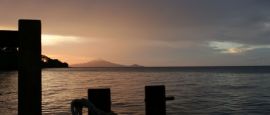Getting around Nicaragua
Given the relative size of the country and the difficulty of some ground travel routes, internal flights are worth considering. La Costeña Airlines (www.lacostena.com.ni) offers domestic flights from Managua to several Nicaraguan destinations, including the Corn Islands, Bluefields and Puerto Cabezas. The period around Easter, Christmas and New Year can get booked up.
Lack of road safety is probably the biggest single hazard to travellers in Nicaragua. Road signs are often poorly labelled or difficult to interpret (when they exist). Vehicles don’t always use their lights and driving at night is not recommended. Many vehicles are in poor condition, travel very slowly and break down or stop without warning. Ignoring traffic lights is common.
Drivers should be especially careful on curves and hills, as many drivers pass or park on blind corners. Speed limits vary depending on the type of road but traffic rules are rarely enforced. Watch out for bicycles, motorbikes, mopeds and oxcarts, and people and animals walking in the road.
The Pan-American Highway, which connects the northern and southern borders, and some main roads connecting major towns and cities are in good condition but other roads can be potholed or unpaved, and can be difficult to navigate in the rainy season.
Major international car hire companies have offices at Managua International Airport and in Managua, Granada, San Juan del Sur, Chinandega, Masaya, Matagalpa and Peñas Blancas. Consider a 4-wheel drive if you’re venturing into the mountains or jungle and check your insurance carefully to see what it covers.
There are taxis at the airport and in towns and cities. With unmetered taxis, agree a fare before you set off. Most city taxis are 'colectivos' that stop and pick up other people. They have set in-town fares – a map of each area in the city determines the price. No tip is expected.
You can often see whole families on rickety old bikes in the countryside, but a sturdy mountain bike is recommended for difficult terrain. It’s easier to rent a bike – especially in Granada, San Juan del Sur, Ometepe and León – than bring your own, but if you do make sure you bring spare parts too, as finding them in Nicaragua can be problematic. Also bring the relevant paperwork to prove that the bike is yours.
Most Nicaraguans travel by bus and many of them are knee-crunching former American school buses known as ‘chicken buses’. Most major destinations have an express service, which may be a more comfortable minibus. It’s more expensive than a regular service but can halve the travel time. You need to buy your express ticket in advance from the (often chaotic) bus terminal or from the driver. Drivers are usually friendly and helpful, although it helps to speak some Spanish.
The minimum driving age is 18 years. Speed limits vary according to the type of road but are rarely enforced. Seat belts must be worn at all times and driving licences must be in the driver's possession when driving. Make sure you carry an emergency triangle and fire extinguisher.
If you break down in a rental car, contact your rental agency. There are no official breakdown services in Nicaragua, so if you’re driving your own vehicle try to get your car into a safe place and make your way to the nearest garage.
Valid national driving licences and international driving licences are accepted, as long as you are over 21 and they’re accompanied by a passport. Insurance is essential.
The bus and minibus services in cities and towns are good, if basic. Many minibuses can be booked through hostel administration. The buses are often crowded, so don’t attempt them with luggage. Pickpocketing is also common. Bus stations can be large, chaotic and confusing. It’s not recommend to travel by bus after dark; if possible use radio-dispatched taxis. If you get a taxi on the street, use an authorised taxi, which has red plates and the driver’s identification number, name and photograph clearly visible on the dashboard. Always agree the fare before you set off.
Do you have any Feedback about this page?
© 2025 Columbus Travel Media Ltd. All rights reserved. No part of this site may be reproduced without our written permission, click here for information on Columbus Content Solutions.




 You know where
You know where